- What We Do
- Agriculture and Food Security
- Democracy, Human Rights and Governance
- Economic Growth and Trade
- Education
- Ending Extreme Poverty
- Environment and Global Climate Change
- Gender Equality and Women's Empowerment
- Global Health
- Water and Sanitation
- Working in Crises and Conflict
- U.S. Global Development Lab
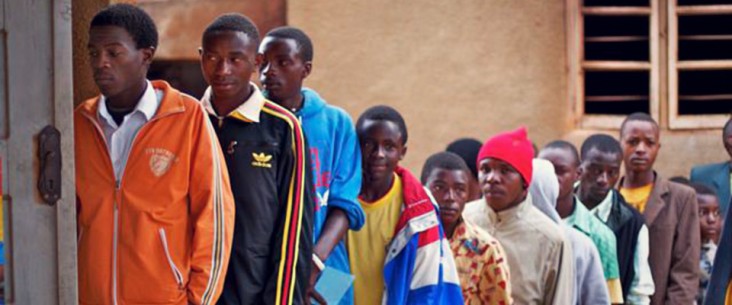
At a Glance
Why Circumcision Matters
The world has an unprecedented opportunity in the next 15 years to prevent an estimated 3 and 1/2 million new HIV infections in Southern and Eastern African countries with high HIV prevalence and low male circumcision prevalence. While access to HIV treatment has increased significantly in this region over the past 5 years, the number of new infections continues to outpace the expansion of treatment. Scale-up of voluntary medical male circumcision (VMMC) is critically important to reduce the future burden of HIV in eastern and southern Africa. VMMC involves a single surgical intervention and offers men substantial lifelong partial protection against the acquisition of HIV and a number of other sexually transmitted diseases. VMMC also offers direct protection against cervical cancer to women. The minimum services to be offered, defined by the World Health Organization (WHO), includes counseling and testing, risk reduction counseling, screening and treatment of sexually transmitted infections, promotion of correct and consistent use of male and female condoms, active referral of HIV-positive men to care and treatments and surgical removal of the foreskin.
Press Corner
Medical Male Circumcision Offers a Gateway to HIV Testing and Medical Check-ups
#AIDS2016: Medical Male Circumcision Saves Millions in Lives and Costs
Tanzania Could Save $3,200 in HIV Fight
Great News for HIV Prevention in Africa
Snip Decision: Africa's Campaign To Circumcise Its Men
Voluntary Medical Male Circumcision for HIV Prevention Finds Success at Scale
Male Circumcision Part 1: How It Can Get Us Closer to an “AIDS-Free Generation”
Male Circumcision Part 2: His Choice and Her Influence
Male Circumcision Part 3: Why Some Men Resist the Next Best Thing to an AIDS Vaccine
Male Circumcision Part 4: “Public Health is a Noble Profession”
Male Circumcision Part 5: Measuring Health Provider Burnout
Quick Expansion of Medical Circumcision Brings Challenges - Study
USAID’s Response
In 2007, WHO and the Joint United Nations Programme on HIV/AIDS (UNAIDS) issued recommendations to implement VMMC in settings with high HIV prevalence and low male circumcision prevalence. The U.S. Agency for International Development (USAID), with funds from the U.S. President’s Emergency Plan for AIDS Relief (PEPFAR), has been at the forefront of introducing, launching and rolling out this effective HIV prevention method in several of the priority countries. USAID has provided technical and financial support for scaling up VMMC in 14 priority countries in Eastern and Southern Africa.
USAID works in close collaboration with the Bill & Melinda Gates Foundation; the Global Fund to Fight AIDS, Tuberculosis and Malaria; WHO; UNAIDS; UNICEF; the World Bank; U.S. Government agencies implementing the PEPFAR program (the Centers for Disease Control and Prevention, the Department of Defense, the National Institutes of Health and the Office of the U.S. Global AIDS Coordinator); and implementing partners.
USAID provides support to host countries’ ministries of health for VMMC scale-up through:
- Technical assistance for program design, implementation and monitoring and evaluation
- Operational research, including introduction of new technologies such as medical devices and male circumcision surgical kits with disposable instruments
- Technical assistance for policy, strategic and operational plan development
- Data for decision-making generated through costing and modeling activities in support of donors and national HIV planning
- Advocacy for use of innovative methods and acceleration of VMMC scale-up
- Development training documents and materials
- Service delivery, including demand creation and communication, human resources for health, logistic and commodity procurement, monitoring and evaluation and quality assurance
- Identification and sharing of best practices
- Supporting south-to-south exchanges
Current Programmatic Highlights
The Strengthening High Impact Interventions for an AIDS-free Generation (AIDSFree) Project improves the quality and effectiveness of high-impact, evidence-based, HIV interventions, such as voluntary medical male circumcision (VMMC), to meet country-specific goals and objectives globally. AIDSFree advances the evidence base around accelerated scale-up of VMMC services through technical assistance, capacity development, knowledge management, analysis, and service delivery support. AIDSFree is led by JSI Research & Training Institute, Inc., with partners: Jhpiego Corp., Abt Associates, Inc., Elizabeth Glaser Pediatric AIDS Foundation, EnCompass, LLC, IMA World Health, International HIV/AIDS Alliance, and PATH.
Project SOAR generates critical evidence and analyses to enable HIV program implementers and national governments to improve programs for HIV care, treatment, and prevention—including voluntary medical male circumcision (VMMC). To support policymakers to make informed decisions about resource allocation for VMMC programs, Project SOAR works with countries to conduct costing and modeling analyses and studies to provide data for decision-making. Population Council leads Project SOAR in partnership with Avenir Health, Elizabeth Glaser Pediatric AIDS Foundation (EGPAF), Futures Group, Johns Hopkins University (JHU), and the University of North Carolina (UNC). Avenir Health implements the VMMC costing and modeling work.
The Health Policy Initiative (HPI) Costing Task Order and the Health Policy Project (HPP) uses the Decision Makers’ Program Planning Tool (DMPPT), developed by HPI in collaboration with UNAIDS, and the Decision Makers’ Program Planning Tool 2.0 (DMPPT 2.0), developed by HPP in collaboration with BMGF, to generate country-specific cost data that (1) inform realistic budgets and targets for VMMC programs; (2) identify the current level of funding required to achieve program goals; and (3) model the costs and impacts of different service delivery models. These two projects are implemented by Futures Group and Futures Institute.
The Applying Science to Strengthen and Improve Systems Project provides technical support to the Uganda Ministry of Health and PEPFAR implementing partners to improve the quality and safety of VMMC services by applying the continuous quality improvement (QI) method. This includes empowering site-level QI teams to identify gaps and test changes to address those gaps, as well as equipping QI teams with the skills to use their own data to improve the quality of care and scale-up best practices through shared learning.
The Health Communication Capacity Collaborative (HC3), managed by John Hopkins University Bloomberg School of Public Health and project partner UNICEF, is conducting an assessment of the quality of communication and care provided by the VMMC program to adolescents and youth populations (10 to 24 years old).
The Partnership for Supply Chain Management System (SCMS) works with the PEPFAR Voluntary Medical Male Circumcision Technical Working Group (VMMC TWG) on the task of leading the procurement and supply chain management of VMMC kits and supplementary commodities. Kit components and supplementary commodities have been agreed upon through consensus of the VMMC TWG partners. As a result, SCMS can apply economies of scale to negotiate the lowest prices possible while maintaining the highest quality product for the VMMC program.
Additional Resources
PLOS Collection: VMMC for HIV Prevention: New Mathematical Models for Prioritizing Sub-Populations by Age & Geography
Published July 2016
PLOS launched a collection of nine USAID-supported manuscripts which discuss new modeling to assess the impacts of focusing VMMC programs on narrower client age groups and specific geographic areas. The collection can assist decision makers in making more informed decisions about which strategies and investments to prioritize to achieve their HIV incidence reduction goals.
Global Health: Science and Practice Journal Collection--Introducing Early Infant Male Circumcision for HIV Prevention: Considerations for Policy, Safety, Cost, Acceptability and Demand
Published July 2016
In collaboration with UNICEF, the Global Health: Science and Practice journal launched a new ten manuscript collection on early infant male circumcision (EIMC) for HIV prevention. This collection offers insights into a few country experiences with introducing EIMC services and highlights important considerations for policy, service delivery, costs, and demand creation.
Integrating Gender in Voluntary Medical Male Circumcision Programs to Improve Outcomes
Published June 2014
Existing research and reports, while limited, concur that women play an important role in VMMC service adoption, men’s adherence to the abstinence period, and outcomes and that negative consequences can occur as a result of lack of knowledge and engagement among female partners.
- Read the technical brief on Integrating Gender in Voluntary Medical Male Circumcision Programs to Improve Outcomes [PDF, 404KB]
VMMC PLOS Medicine Collections
Voluntary Medical Male Circumcision for HIV Prevention: Improving Quality, Efficiency, Cost Effectiveness, and Demand for Services during an Accelerated Scale-Up
Published May 2014
With new HIV infections in Sub-Saharan Africa occurring at a rate of 2.3 million each year, this new Collection, featuring research published in PLOS Medicine and PLOS ONE, presents interim results from a large public health intervention of voluntary medical male circumcision (VMMC) performed by health care practitioners in low-resource settings to prevent new infections.
The Collection examines lessons learned from the scaled-up VMMC program since 2008. Research papers focus on programs in Kenya, South Africa, Tanzania, Zimbabwe and Lesotho, identifying strengths and challenges in key program areas, including demand creation, the quality of surgical services, operational efficiencies, data collection and cost controls.
The VMMC program faces challenges at multiple levels, such as maintaining quality of services while rapidly scaling up, generating demand, and resource and capacity constraints. In order to accelerate scale-up and impact, the Collection authors recommendations include increasing program efficiency by identifying and prioritizing those most at risk of acquiring HIV, matching supply with demand, and exploring the role of technology.
- View the 2014 collection on Voluntary Medical Male Circumcision for HIV Prevention: Improving Quality, Efficiency, Cost Effectiveness, and Demand for Services during an Accelerated Scale-Up
Voluntary Medical Male Circumcision for HIV Prevention: The Cost, Impact, and Challenges of Accelerated Scale-Up in Southern and Eastern Africa
Published November 2011
This sponsored collection of nine new articles, includes four reviews and five research articles, published in PLoS Medicine and PLoS ONE, in conjunction with the Joint United Nations Programme on HIV/AIDS (UNAIDS) and the United States President's Emergency Plan for AIDS Relief (PEPFAR).
- View the 2011 collection on Voluntary Medical Male Circumcision for HIV Prevention: The Cost, Impact, and Challenges of Accelerated Scale-Up in Southern and Eastern Africa
PEPFAR’s Best Practices for Voluntary Medical Male Circumcision Site Operations: A Service Guide for Site Operations
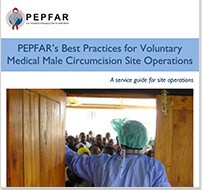
PEPFAR’s Best Practices for Voluntary Medical Male Circumcision Site Operations: A Service Guide for Site Operations provides implementing partners with a comprehensive and consistent process for establishing new VMMC services for HIV prevention. The scope of this document is limited to establishing and supporting quality VMMC services for HIV prevention at the facility or VMMC site level.
- Read or download the entire PEPFAR Best Practices document [PDF, 835 KB]
In It to Save Lives: Scaling Up Voluntary Medical Male Circumcision for HIV Prevention for Maximum Public Health Impact
In It to Save Lives: Scaling Up Voluntary Medical Male Circumcision for HIV Prevention for Maximum Public Health Impact was produced by AIDSTAR-One, a PEPFAR-funded USAID project. This 16-minute film explains how governments in Kenya and Swaziland have embraced VMMC for HIV prevention.
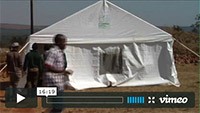
A complementary video discussion guide, resource packet and DVD download/request form are available here.
How to use the In It to Save Lives video as an advocacy tool:
- Download the video to share with others, including community and political leaders
- Use the accompanying discussion guide [PDF, 191KB] after viewing the movie. It uses everyday language to provide answers to some frequently asked questions about VMMC
- Use the accompanying resource packet; its resources and websites provide more detailed information about specific aspects of medical male circumcision that are relevant to multiple audiences
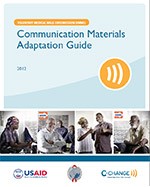
C-Change Communication Materials Adaptation Guide
Communication Materials Adaptation Guide was produced by the Communication for Change (C-Change) project and offers comprehensive guidance on communication programs scaling up services in new settings. It outlines a 10-step, participatory process for adapting materials to make them appealing and relevant to new audiences.
- Download the Communication Materials Adaptation Guide [PDF, 1.9 MB]
Press Corner
Tanzania Could Save $3,200 in HIV Fight
Great News for HIV Prevention in Africa
Snip Decision: Africa's Campaign To Circumcise Its Men
Voluntary Medical Male Circumcision for HIV Prevention Finds Success at Scale
Male Circumcision Part 1: How It Can Get Us Closer to an “AIDS-Free Generation”
Male Circumcision Part 2: His Choice and Her Influence
Male Circumcision Part 3: Why Some Men Resist the Next Best Thing to an AIDS Vaccine
Male Circumcision Part 4: “Public Health is a Noble Profession”
Male Circumcision Part 5: Measuring Health Provider Burnout
Quick Expansion of Medical Circumcision Brings Challenges - Study







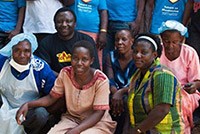
Comment
Make a general inquiry or suggest an improvement.